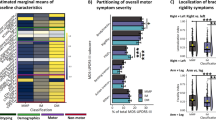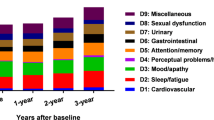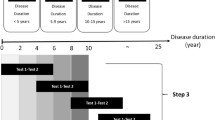Abstract
The cardinal symptoms of Parkinson disease (PD) are asymmetrical bradykinesia, rigidity, resting tremor and postural instability. However, the presence and spectrum of, and disability caused by, nonmotor symptoms (NMS) are being increasingly recognized. NMS include dementia, psychosis, depression and apathy, and are a major source of disability in later stages of PD, in association with axial symptoms that are resistant to levodopa therapy. The model of clinical progression of PD should, therefore, incorporate NMS, instead of being restricted to motor signs and levodopa-induced motor complications. Patients with disabling motor complications are classified as having advanced PD, which has been thought to represent the ultimate stage of disease. However, deep brain stimulation to treat motor complications has dramatically changed this scenario, with implications for the definition of advanced-stage disease. As treatment improves and survival times increase, patients are increasingly progressing to a later phase of disease in which they are highly dependent on caregivers, and disability is dominated by motor symptoms and NMS that are resistant to levodopa. In this article, we review the changing landscape of the later stages of PD, and propose a definition of late-stage PD to designate patients who have progressed beyond the advanced stage.
Key Points
-
Advanced-stage Parkinson disease (PD) is widely accepted as a term to denote patients with motor complications, but many patients continue to progress to a less well-defined stage
-
Late stages of PD are of increasing clinical relevance owing to improved treatment and survival
-
Progression of PD is characterized by worsening disability owing to motor complications, nonmotor symptoms (NMS) and motor symptoms that are unresponsive to levodopa
-
Disability in late stages of PD is mostly associated with NMS such as dementia, psychosis and dysautonomia, and motor symptoms that are unresponsive to levodopa, such as dysarthria and falls
-
We propose a definition of late-stage PD in which patients are highly dependent on caregivers for activities of daily living, owing to motor symptoms or NMS that are resistant to levodopa
-
Future research should focus on the pathogenic mechanisms underlying late-stage PD, which could highlight therapeutic targets and potential end points for clinical trials
This is a preview of subscription content, access via your institution
Access options
Subscribe to this journal
Receive 12 print issues and online access
$209.00 per year
only $17.42 per issue
Buy this article
- Purchase on Springer Link
- Instant access to full article PDF
Prices may be subject to local taxes which are calculated during checkout

Similar content being viewed by others
References
de Rijk, M. C. et al. Prevalence of Parkinson's disease in Europe: a collaborative study of population-based cohorts. Neurologic Diseases in the Elderly Research Group. Neurology 54, S21–S23 (2000).
Zhang, Z. X. & Roman, G. C. Worldwide occurrence of Parkinson's disease: an updated review. Neuroepidemiology 12, 195–208 (1993).
Wakayama, K. et al. Quantitative measurement of neurological deficit after mild (30 min) transient middle cerebral artery occlusion in rats. Brain Res. 1130, 181–187 (2007).
Shulman, L. M. et al. The evolution of disability in Parkinson disease. Mov. Disord. 23, 790–796 (2008).
Willis, A. W. et al. Predictors of survival in patients with Parkinson disease. Arch. Neurol. 69, 601–607 (2012).
Schapira, A. H. et al. Novel pharmacological targets for the treatment of Parkinson's disease. Nat. Rev. Drug Discov. 5, 845–854 (2006).
Brooks, D. J. Imaging non-dopaminergic function in Parkinson's disease. Mol. Imaging Biol. 9, 217–222 (2007).
Tolosa, E, Wenning, G & Poewe, W. The diagnosis of Parkinson's disease. Lancet Neurol. 5, 75–86 (2006).
Chaudhuri, K. R., Healy, D. G. & Schapira, A. H. Non-motor symptoms of Parkinson's disease: diagnosis and management. Lancet Neurol. 5, 235–245 (2006).
Olanow, C. W. et al. Levodopa in the treatment of Parkinson's disease: current controversies. Mov. Disord. 19, 997–1005 (2004).
Chapuis, S., Ouchchane, L., Metz, O., Gerbaud, L. & Durif, F. Impact of the motor complications of Parkinson's disease on the quality of life. Mov. Disord. 20, 224–230 (2005).
Poewe, W. & Mahlknecht, P. The clinical progression of Parkinson's disease. Parkinsonism Relat. Disord. 15 (Suppl. 4), S28–S32 (2009).
Bonnet, A. M., Loria, Y., Saint-Hilaire, M. H., Lhermitte, F. & Agid, Y. Does long-term aggravation of Parkinson's disease result from nondopaminergic lesions? Neurology 37, 1539–1542 (1987).
Ahlskog, J. E. & Muenter, M. D. Frequency of levodopa-related dyskinesias and motor fluctuations as estimated from the cumulative literature. Mov. Disord. 16, 448–458 (2001).
Schrag, A., Sampaio, C., Counsell, N. & Poewe, W. Minimal clinically important change on the unified Parkinson's disease rating scale. Mov. Disord. 21, 1200–1207 (2006).
Fahn, S., Elton, R. & Members of the UPDRS Development Committee in Recent Developments in Parkinson's Disease (eds Fahn, S. et al.) 153–163 (Macmillan Health Care Information, Florham Park, NJ, 1987).
Shulman, L. M. et al. The clinically important difference on the unified Parkinson's disease rating scale. Arch. Neurol. 67, 64–70 (2010).
Cotzias, G. C., Papavasiliou, P. S. & Gellene, R. Modification of Parkinsonism—chronic treatment with L-dopa. N. Engl. J. Med. 280, 337–345 (1969).
Hauser, R. A., McDermott, M. P. & Messing, S. Factors associated with the development of motor fluctuations and dyskinesias in Parkinson disease. Arch. Neurol. 63, 1756–1760 (2006).
Schrag, A. & Quinn, N. Dyskinesias and motor fluctuations in Parkinson's disease. A community-based study. Brain 123, 2297–2305 (2000).
Fahn, S. et al. Levodopa and the progression of Parkinson's disease. N. Engl. J. Med. 351, 2498–2508 (2004).
Pechevis, M. et al. Effects of dyskinesias in Parkinson's disease on quality of life and health-related costs: a prospective European study. Eur. J. Neurol. 12, 956–963 (2005).
Schrag, A., Jahanshahi, M. & Quinn, N. How does Parkinson's disease affect quality of life? A comparison with quality of life in the general population. Mov. Disord. 15, 1112–1118 (2000).
Hely, M. A., Morris, J. G., Reid, W. G. & Trafficante, R. Sydney Multicenter Study of Parkinson's disease: non-L-dopa-responsive problems dominate at 15 years. Mov. Disord. 20, 190–199 (2005).
Hely, M. A., Reid, W. G., Adena, M. A., Halliday, G. M. & Morris, J. G. The Sydney multicenter study of Parkinson's disease: the inevitability of dementia at 20 years. Mov. Disord. 23, 837–844 (2008).
Coelho, M. et al. Late-stage Parkinson's disease: the Barcelona and Lisbon cohort. J. Neurol. 257, 1524–1532 (2010).
Papapetropoulos, S. & Mash, D. C. Motor fluctuations and dyskinesias in advanced/end stage Parkinson's disease: a study from a population of brain donors. J. Neural. Transm. 114, 341–345 (2007).
Forsaa, E. B., Larsen, J. P., Wentzel-Larsen, T. & Alves, G. What predicts mortality in Parkinson disease? A prospective population-based long-term study. Neurology 75, 1270–1276 (2010).
Forsaa, E. B. et al. A 12-year population-based study of psychosis in Parkinson disease. Arch. Neurol. 67, 996–1001 (2010).
Buter, T. C. et al. Dementia and survival in Parkinson disease: a 12-year population study. Neurology 70, 1017–1022 (2008).
Papapetropoulos, S., Gonzalez, J., Lieberman, A., Villar, J. M. & Mash, D. C. Dementia in Parkinson's disease: a post-mortem study in a population of brain donors. Int. J. Geriatr. Psychiatry 20, 418–422 (2005).
Schrag, A., Jahanshahi, M. & Quinn, N. What contributes to quality of life in patients with Parkinson's disease? J. Neurol. Neurosurg. Psychiatry 69, 308–312 (2000).
Goetz, C. G. & Stebbins, G. T. Mortality and hallucinations in nursing home patients with advanced Parkinson's disease. Neurology 45, 669–671 (1995).
van Rooden, S. M., Visser, M., Verbaan, D., Marinus, J. & van Hilten, J. J. Patterns of motor and non-motor features in Parkinson's disease. J. Neurol. Neurosurg. Psychiatry 80, 846–850 (2009).
Iranzo, A. et al. Rapid-eye-movement sleep behaviour disorder as an early marker for a neurodegenerative disorder: a descriptive study. Lancet Neurol. 5, 572–577 (2006).
Braak, H. et al. Staging of brain pathology related to sporadic Parkinson's disease. Neurobiol. Aging 24, 197–211 (2003).
Hoehn, M. M. & Yahr, M. D. Parkinsonism: onset, progression and mortality. Neurology 17, 427–442 (1967).
Goetz, C. G. et al. Movement Disorder Society Task Force report on the Hoehn and Yahr staging scale: status and recommendations. Mov. Disord. 19, 1020–1028 (2004).
Mitchell, S. L., Harper, D. W., Lau, A. & Bhalla, R. Patterns of outcome measurement in Parkinson's disease clinical trials. Neuroepidemiology 19, 100–108 (2000).
Welsh, M. et al. Development and testing of the Parkinson's disease quality of life scale. Mov. Disord. 18, 637–645 (2003).
Reynolds, N. C. Jr & Montgomery, G. K. Factor analysis of Parkinson's impairment. An evaluation of the final common pathway. Arch. Neurol. 44, 1013–1016 (1987).
Goetz, C. G., Stebbins, G. T. & Blasucci, L. M. Differential progression of motor impairment in levodopa-treated Parkinson's disease. Mov. Disord. 15, 479–484 (2000).
Slawek, J., Derejko, M. & Lass, P. Factors affecting the quality of life of patients with idiopathic Parkinson's disease—a cross-sectional study in an outpatient clinic attendees. Parkinsonism Relat. Disord. 11, 465–468 (2005).
Goetz, C. G. Treatment of advanced Parkinson's disease: an evidence-based analysis. Adv. Neurol. 91, 213–228 (2003).
Schrag, A. et al. Rate of clinical progression in Parkinson's disease. A prospective study. Mov. Disord. 22, 938–945 (2007).
Obeso, J. A. et al. The evolution and origin of motor complications in Parkinson's disease. Neurology 55, S13–S20 (2000).
Tolosa, E. & Katzenschlager, R. in Parkinson's Disease and Movement Disorders (eds Jankovic, J. & Tolosa, E.) 110–145 (Lippincott, Williams & Wilkins, Philadelphia, 2007).
Limousin, P. et al. Effect of parkinsonian signs and symptoms of bilateral subthalamic nucleus stimulation. Lancet 345, 91–95 (1995).
Krack, P. et al. Five-year follow-up of bilateral stimulation of the subthalamic nucleus in advanced Parkinson's disease. N. Engl. J. Med. 349, 1925–1934 (2003).
Deuschl, G. et al. A randomized trial of deep-brain stimulation for Parkinson's disease. N. Engl. J. Med. 355, 896–908 (2006).
Fasano, A. et al. Motor and cognitive outcome in patients with Parkinson's disease 8 years after subthalamic implants. Brain 133, 2664–2676 (2010).
Follett, K. A. et al. Pallidal versus subthalamic deep-brain stimulation for Parkinson's disease. N. Engl. J. Med. 362, 2077–2091 (2010).
Lagrange, E. et al. Bilateral subthalamic nucleus stimulation improves health-related quality of life in PD. Neurology 59, 1976–1978 (2002).
Williams, A. et al. Deep brain stimulation plus best medical therapy versus best medical therapy alone for advanced Parkinson's disease (PD SURG trial): a randomised, open-label trial. Lancet Neurol. 9, 581–591 (2010).
Weaver, F. M. et al. Bilateral deep brain stimulation vs best medical therapy for patients with advanced Parkinson disease: a randomized controlled trial. JAMA 301, 63–73 (2009).
Castrioto, A. et al. Ten-year outcome of subthalamic stimulation in Parkinson disease: a blinded evaluation. Arch. Neurol. 68, 1550–1556 (2011).
Rascol, O. et al. Rasagiline as an adjunct to levodopa in patients with Parkinson's disease and motor fluctuations (LARGO, Lasting effect in Adjunct therapy with Rasagiline Given Once daily, study): a randomised, double-blind, parallel-group trial. Lancet 365, 947–954 (2005).
Emre, M. et al. Memantine for patients with Parkinson's disease dementia or dementia with Lewy bodies: a randomised, double-blind, placebo-controlled trial. Lancet Neurol. 9, 969–977 (2010).
Barone, P. et al. The PRIAMO study: a multicenter assessment of nonmotor symptoms and their impact on quality of life in Parkinson's disease. Mov. Disord. 24, 1641–1649 (2009).
Riedel, O. et al. Frequency of dementia, depression, and other neuropsychiatric symptoms in 1449 outpatients with Parkinson's disease. J. Neurol. 257, 1073–1082 (2010).
Schwab, R. S. & England, A. Projection technique for evaluating surgery in Parkinson's disease in 3rd Symposium on Parkinson's Disease (eds Gillingham, F. J. & Donaldson, M. C.) 152–157 (Livingstone, Edinburgh, 1969).
Martinez-Martin, P. et al. Intermediate scale for assessment of Parkinson's disease. Characteristics and structure. Parkinsonism Relat. Disord. 1, 97–102 (1995).
Martinez-Martin, P. et al. Unified Parkinson's Disease Rating Scale characteristics and structure. The Cooperative Multicentric Group. Mov. Disord. 9, 76–83 (1994).
Martin, W. E., Loewenson, R. B., Resch, J. A. & Baker, A. B. Parkinson's disease. Clinical analysis of 100 patients. Neurology 23, 783–790 (1973).
Goetz, C. G., Ouyang, B., Negron, A. & Stebbins, G. T. Hallucinations and sleep disorders in PD: ten-year prospective longitudinal study. Neurology 75, 1773–1779 (2010).
Pedersen, K. F., Alves, G., Aarsland, D. & Larsen, J. P. Occurrence and risk factors for apathy in Parkinson disease: a 4-year prospective longitudinal study. J. Neurol. Neurosurg. Psychiatry 80, 1279–1282 (2009).
Aarsland, D. et al. Range of neuropsychiatric disturbances in patients with Parkinson's disease. J. Neurol. Neurosurg. Psychiatry 67, 492–496 (1999).
Aarsland, D. et al. Neuropsychiatric symptoms in patients with Parkinson's disease and dementia: frequency, profile and associated care giver stress. J. Neurol. Neurosurg. Psychiatry 78, 36–42 (2007).
Kempster, P. A. et al. Patterns of levodopa response in Parkinson's disease: a clinico-pathological study. Brain 130, 2123–2128 (2007).
Joyce, J. N. et al. Loss of response to levodopa in Parkinson's disease and co-occurrence with dementia: role of D3 and not D2 receptors. Brain Res. 955, 138–152 (2002).
Clissold, B. G., McColl, C. D., Reardon, K. R., Shiff, M. & Kempster, P. A. Longitudinal study of the motor response to levodopa in Parkinson's disease. Mov. Disord. 21, 2116–2121 (2006).
Goetz, C. G. & Stebbins, G. T. Risk factors for nursing home placement in advanced Parkinson's disease. Neurology 43, 2227–2229 (1993).
Aarsland, D., Larsen, J. P., Tandberg, E. & Laake, K. Predictors of nursing home placement in Parkinson's disease: a population-based, prospective study. J. Am. Geriatr. Soc. 48, 938–942 (2000).
Hely, M. A. et al. The Sydney multicentre study of Parkinson's disease: progression and mortality at 10 years. J. Neurol. Neurosurg. Psychiatry 67, 300–307 (1999).
Kempster, P. A., O'Sullivan, S. S., Holton, J. L., Revesz, T. & Lees, A. J. Relationships between age and late progression of Parkinson's disease: a clinico-pathological study. Brain 133, 1755–1762 (2010).
Clarke, C. E. Mortality from Parkinson's disease in England and Wales 1921–1989. J. Neurol. Neurosurg. Psychiatry 56, 690–693 (1993).
Chaudhuri, K. R. et al. The nondeclaration of nonmotor symptoms of Parkinson's disease to health care professionals: an international study using the nonmotor symptoms questionnaire. Mov. Disord. 25, 697–701 (2010).
Dickson, D. W. et al. Neuropathology of non-motor features of Parkinson disease. Parkinsonism Relat. Disord. 15 (Suppl. 3), S1–S5 (2009).
Dickson, D. W. et al. Neuropathological assessment of Parkinson's disease: refining the diagnostic criteria. Lancet Neurol. 8, 1150–1157 (2009).
Lim, S. Y., Fox, S. H. & Lang, A. E. Overview of the extranigral aspects of Parkinson disease. Arch. Neurol. 66, 167–172 (2009).
Colosimo, C., Hughes, A. J., Kilford, L. & Lees, A. J. Lewy body cortical involvement may not always predict dementia in Parkinson's disease. J. Neurol. Neurosurg. Psychiatry 74, 852–856 (2003).
Harding, A. J., Broe, G. A. & Halliday, G. M. Visual hallucinations in Lewy body disease relate to Lewy bodies in the temporal lobe. Brain 125, 391–403 (2002).
Yarnall, A., Rochester, L. & Burn, D. J. The interplay of cholinergic function, attention, and falls in Parkinson's disease. Mov. Disord. 26, 2496–2503 (2011).
Collerton, D., Perry, E. & McKeith, I. Why people see things that are not there: a novel Perception and Attention Deficit model for recurrent complex visual hallucinations. Behav. Brain Sci. 28, 737–757 (2005).
Braak, H., Rub, U., Jansen Steur, E. N., Del Tredici, K. & de Vos, R. A. Cognitive status correlates with neuropathologic stage in Parkinson disease. Neurology 64, 1404–1410 (2005).
Katzenschlager, R. et al. Fourteen-year final report of the randomized PDRG-UK trial comparing three initial treatments in PD. Neurology 71, 474–480 (2008).
Aarsland, D. et al. Memantine in patients with Parkinson's disease dementia or dementia with Lewy bodies: a double-blind, placebo-controlled, multicentre trial. Lancet Neurol. 8, 613–618 (2009).
Leroi, I., Overshott, R., Byrne, E. J., Daniel, E. & Burns, A. Randomized controlled trial of memantine in dementia associated with Parkinson's disease. Mov. Disord. 24, 1217–1221 (2009).
Emre, M. et al. Rivastigmine for dementia associated with Parkinson's disease. N. Engl. J. Med. 351, 2509–2518 (2004).
Author information
Authors and Affiliations
Corresponding author
Ethics declarations
Competing interests
The authors declare no competing financial interests.
Rights and permissions
About this article
Cite this article
Coelho, M., Ferreira, J. Late-stage Parkinson disease. Nat Rev Neurol 8, 435–442 (2012). https://doi.org/10.1038/nrneurol.2012.126
Published:
Issue Date:
DOI: https://doi.org/10.1038/nrneurol.2012.126



